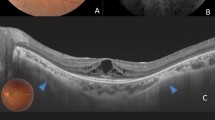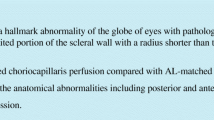Abstract
Purpose
We aimed to study the morphological characteristics of myopic posterior staphyloma in Caucasians and to evaluate the correlation between posterior staphyloma, myopic macular lesions and visual acuity.
Methods
Ninety eyes of 67 consecutive patients affected by high myopia associated with posterior staphyloma were recruited between January 2012 and December 2013. Posterior staphyloma was classified according to Curtin’s criteria. Every patient underwent fundoscopic examination and best corrected visual acuity measurement (BCVA). A and B-scan ultrasound (US), high-resolution, three-dimensional magnetic resonance image (MRI), optical coherence tomography (OCT), fundus autofluorescence (FAF), red free (RF) and color fundus photography studies were performed.
Results
The mean age was 64.4 ± 9.48 years (range: 41–82). The mean BCVA was 0.7 ± 0.5 logMAR (range: 0–2). The mean axial length was 29.92 ± 2.39 millimeters (range: 24.25-36.53). The authors found four types of posterior staphyloma according to Curtin’s classification: I, II, IV and IX. Significant prevalence of posterior staphyloma in female sex was observed (p = 0.0235). Significant correlation between the depth and the diameters of posterior staphyloma was demonstrated (p < 0.0001). Significant association between posterior staphyloma type and tomographic foveal patterns (p = 0.0230) was highlighted. Posterior staphyloma type I was more frequently associated with peripapillary atrophy and less with macular atrophy compared to type II and IX (p = 0.0169). The prevalence of macular atrophy was more than double in posterior staphyloma type II (33.3 %) in comparison to posterior staphyloma type I (12.5 %).
Conclusions
This study confirms that the type I and II are the most common types of posterior staphyloma, as already highlighted in the literature. A significant association between the type of posterior staphyloma and the MRI ocular shape pattern, the OCT patterns of macular profile and the location of chorioretinal atrophy was highlighted. The correlation between the depth and the width of posterior staphyloma has demonstrated that the deeper the staphyloma, the wider it was. The deepest area of the posterior staphyloma was characterized by a greater thinning of the sclera and by a higher prevalence of chorioretinal atrophy compared to the other parts of the eye. More studies are necessary to support our findings and to add more information on the natural evolution of posterior staphyloma and on its associated complications.









Similar content being viewed by others
References
Resnikoff S, Pascolini D, Mariotti SP et al (2008) Global magnitude of visual impairment caused by uncorrected refractive errors in 2004. Bull World Health Organ 86:63–70
Junghans B, Kiely PM, Crewther DP et al (2002) Referral rates for a functional vision screening among a large cosmopolitan sample of Australian children. Ophthalmic Physiol Opt 22:10–25
Kleinstein RN, Jones LA, Hullett S et al (2003) Refractive error and ethnicity in children. Arch Ophthalmol 121:1141–1147
Lam CS, Goldschmidt E, Edwards MH (2004) Prevalence of myopia in local and international schools in Hong Kong. Optom Vis Sci 81:317–322
Cumberland PM, Peckham CS, Rahi JS (2007) Inferring myopia over the lifecourse from uncorrected distance visual acuity in childhood. Br J Ophthalmol 91:151–153
Foster PJ, Jiang Y (2014) Epidemiology of myopia. Eye 28:202–208
Morgan I, Rose K (2005) How genetic is school myopia? Prog Retin Eye Res 24:1–38
Pan CW, Ramamurthy D, Saw SM (2012) Worldwide prevalence and risk factors for myopia. Ophthalmic Physiol Opt 32:3–16
LinLL SYF, Hsiao CK, Chen CJ (2004) Prevalence of myopia in Taiwanese school children:1983 to 2000. Ann Acad Med Singapore 33:27–33
Katz J, Tielsch JM, Sommer A (1997) Prevalence and risk factors for refractive errors in an adult inner city population. Invest Ophthalmol Vis Sci 38:334–340
Vitale S, Sperduto RD, Ferris FL 3rd (2009) Increased prevalence of myopia in the United States between 1971–1972 and 1994–2004. Arch Ophthalmol 127:1632–1639
Spaide RF, Ohno-Matsui K, Yannuzzi LA, eds (2013) Pathologic Myopia. New York: Springer; 177–85
Curtin BJ (1977) The posterior Staphyloma of pathological myopia. Trans Am Ophthalmol Soc 75:67–86
Hsiang HW, Ohno-Matsui K, Shimada N et al (2008) Clinical characteristics of posterior staphyloma in eyes with pathologic myopia. Am J Ophthalmol 146(1):102–110
Yasushi Ikuno and Masahito (2013) Ohji Retina Chapter. In High myopia and the vitreoretinal complications. Fifth edn113, 1912–1919
Ohno-Matsui K, Akiba M, Modegi T et al (2012) Association between shape of sclera and myopic retinochoroidal lesions in patients with pathological myopia. Invest Ophtalmol Vis Sci 53(10):6046–6061
Ohno-Matsui K (2014) Proposed classification of posterior staphylomas based on analyses of Eye shape by three-dimensional magnetic resonance imaging and wide-field fundus imaging. Ophthalmology 12(9):1798–1809
Moriyama M, Ohno-Matsui K, Hayashi K, Shimada N et al (2011) Topographic analysis of shape of eyes with pathologic myopia by high resolution three-dimensional magnetic resonance imaging. Ophthalmology 118(8):1626–1637
Rohrschneider K (2004) Determination of the location of the fovea on the fundus. Invest Ophthalmol Vis Sci 45(9):3257–3258
Hayashi K, Ohno-Matsui K, Shimada N et al (2010) Long term pattern of progression of myopic maculopathy: a natural history study. Ophthalmology 117(8):1595–1611
Lui HH, Xu L, Wang YX, Wang S et al (2010) Prevalence and progression of myopic retinopathy in Chinese adults: the Beijing Eye Study. Ophthalmology 117(9):1763–1768
Lan Chang, Chen-Wei Pan, Kyoko Ohno-matsui et al. (2013) Myopia – related fundus changes in Singapore Adults with High Myopia. American Journal Ophthalmology 991–999
Curtin BJ (1985) Basic science and clinical management. In: The Myopias. ; Harper and Row, New York, NY
Baba T, Ohno-Matsui K, Futagami S, Yoshida T et al (2003) Prevalence and characteristics of foveal retinal detachment without macular hole in high myopia. Am J Ophthalmol 135(3):338–342
Author information
Authors and Affiliations
Corresponding author
Ethics declarations
Conflict of interest
The authors certify that they have no affiliations with or involvement in any organization or entity with any financial interest (such as honoraria; educational grants; participation in speakers' bureaus; membership, employment, consultancies, stock ownership, or other equity interest; and expert testimony or patent-licensing arrangements), or non-financial interest (such as personal or professional relationships, affiliations, knowledge or beliefs) in the subject matter or materials discussed in this manuscript.
All procedures performed in studies involving human participants were in accordance with the ethical standards of the institutional and/or national research committee and with the 1964 Helsinki declaration and its later amendments or comparable ethical standards.
For this type of study, formal consent is not required.
Funding
No funding was received for this research.
Rights and permissions
About this article
Cite this article
Frisina, R., Baldi, A., Cesana, B.M. et al. Morphological and clinical characteristics of myopic posterior staphyloma in Caucasians. Graefes Arch Clin Exp Ophthalmol 254, 2119–2129 (2016). https://doi.org/10.1007/s00417-016-3359-1
Received:
Revised:
Accepted:
Published:
Issue Date:
DOI: https://doi.org/10.1007/s00417-016-3359-1




